Connected Ship Market Insights, 2032
The global connected ship market size was valued at $ 6,801.3 million in 2022 and is estimated to reach $ 12,262.0 million by 2032, exhibiting a CAGR of 6.3% from 2023 to 2032.
Report Key Highlighters:
The connected ship market study covers 14 countries. The research includes regional and segment analysis of each country in terms of value ($million) for the projected period 2023-2032.
The study integrated high-quality data, professional opinions and analysis, and critical independent perspectives. The research approach is intended to provide a balanced view of global markets and to assist stakeholders in making educated decisions to achieve their most ambitious growth objectives.
Over 3,700 product literature, annual reports, industry statements, and other comparable materials from major industry participants were reviewed to gain a better understanding of the market.
The connected ship market share is slightly fragmented, into several players including ABB Ltd., Emerson Electric, General Electric, Kongsberg Gruppen, Marlink, Northrop Grumman Corporation, Rockwell Automation, Schneider Electric, Ulstein Group ASA, and Wartsila Corporation. The companies have adopted strategies such as product launch, product development and others to improve their market positioning.
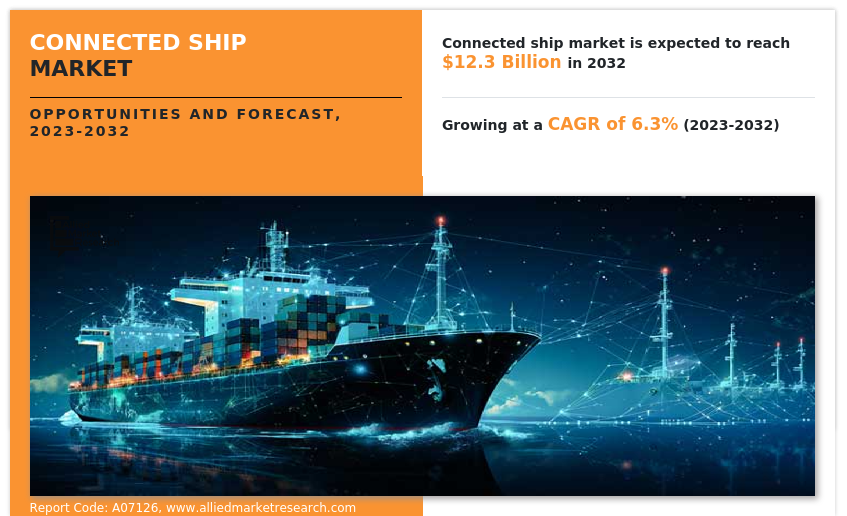
A connected ship refers to a maritime vessel that is equipped with advanced communication technologies and systems to enable seamless connectivity and data exchange. These technologies are designed to improve various areas of ship operations, safety, efficiency, and overall performance. The key aims include increased efficiency of operations, lower expenses, better security and real-time information for informed decision making. As technology progresses, the idea of connected ships is expected to also develop and change because new ones are emerging.
As global maritime operations become more crucial, with an increased need for enhanced operational efficiency and safety aboard ships, the demand for improved connected ship technologies follows suit. Connected ships use advanced communication technologies and data analytics to optimize navigation, vessel performance monitoring, which is expected to improve their overall efficiency in terms of operations. In addition, government support and regulatory initiatives to also have a crucial role in promoting the connected ship market. Various maritime authorities across the globe promote installation of smart technologies to improve safety and environmental sustainability in shipping. Take, for example, the regulatory frameworks that require shipowners to implement electronic chart display and information systems (ECDIS), prompting them to purchase connectivity solutions.
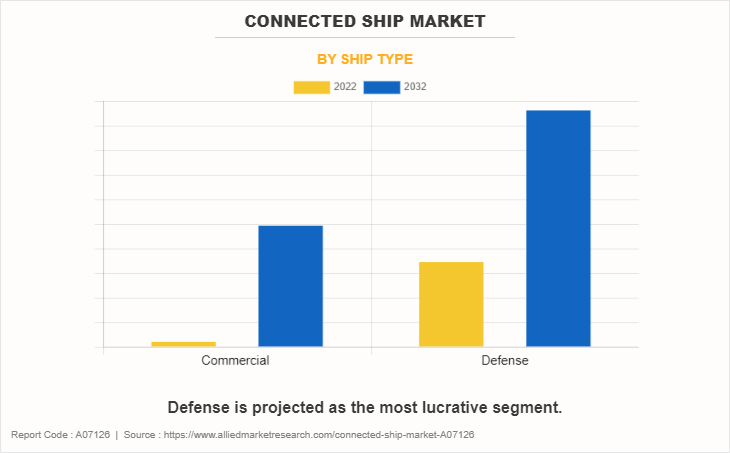
Furthermore, connected ship market demand is increasingly seen as a very good thing in the marine industry. An increasing number of shipowners and operators see potential for cost savings through fuel efficiency enhancements, predictive maintenance procedures as well as optimized route planning. This awareness is driving investments in connectivity solutions across the sector. Despite the upbeat trend some limitations remain. Cybersecurity concerns and the possibility of ship systems being vulnerable to cyber threats are some factors that hold back certain stakeholders from adopting these technologies with open arms. With that in mind, ensuring effective cyber security measures can help reduce these concerns and facilitate trust when implementing connected ship solutions.
In addition, the connected ship market trends are further, driven by the ongoing technological advancements and innovations in the maritime sector. For example, the integration of artificial intelligence and machine learning in connected ship systems opens new possibilities for predictive analytics, fault detection, and decision support systems. The increasing availability of high-speed satellite communication further enhances the potential for real-time data exchange and remote monitoring.
The connected ship market is segmented into application, installation type, ship type, and region. Depending on the application, the market is segregated into fleet operations, vessel traffic management and fleet health monitoring. By installation type, it is categorized into on-board and onshore. As a ship type, it is fragmented into commercial and defense. Region-wise, the market is analyzed across North America, Europe, Asia-Pacific, and LAMEA.
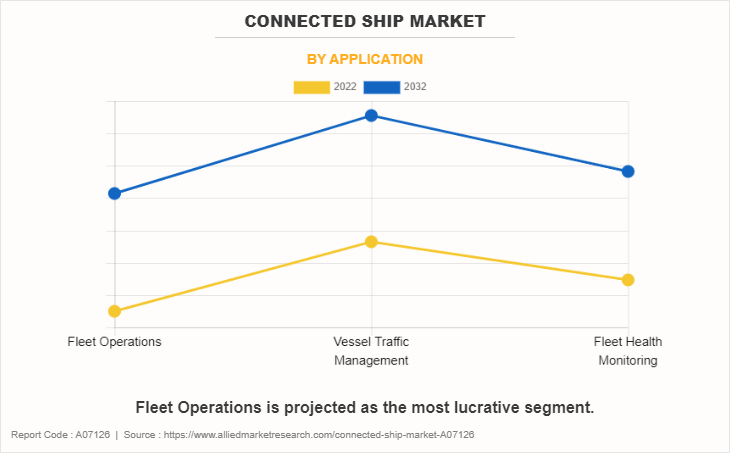
As Asia-Pacific maritime trade and shipping activities continue to expand, the region remains a dominant contributor to global trade volumes. Stakeholders are therefore becoming more aware of the necessity of adopting highly sophisticated connectivity solutions in their operations so that they can remain relevant with stiff competition around them. Government support plays an important role in the promotion of connected ship technologies across Asia Pacific as well. Many governments in countries such as Japan, South Korea and China are actively pushing for the digitalization of maritime operations via policies and incentives. One such initiative is the Chinese Smart Ocean, or Japan's attempts to incorporate digital technologies into shipping, which reflects a larger pattern encouraging connected ship systems in support of maritime strength. The marine industry is dynamic and rapidly changing in the Asia-Pacific region, which leads to the connected ship market growth.
The market players are making an effort to have connected ships solutions to ease their operations, navigate with optimized navigational routes whenever possible. The efforts from these market players in the marine industry are a catalyst for wide acceptance of connected ship technologies across the region. On the other hand, there are certain restraints associated with positive momentum, such as security of data and cybersecurity. To tackle these issues, governments and other stakeholders of the Asia-Pacific region are collaborating in efforts to create strong cybersecurity frameworks and standards. It is imperative to overcome these challenges and ensure sustainable market growth by enhancing the connected ship systemsa resilience with collaborated efforts.
Key Developments in the Connected Ship Industry
The leading companies are adopting strategies such as acquisition, agreement, expansion, partnership, contracts, and product launches to strengthen their market position.
In April 2023, Seaspan Shipyards awarded USD 2.6 million to a Canadian company to develop cutting-edge digital technologies that is expected to energize the shipbuilding industry. The deal includes partnerships with companies that is expected to use Seaspan's revolutionary Digital Holoship program as the basis for their own new marine technology developments.
In October 2022, Kongsberg Digital and Alpha Ori Technologies entered a new partnership agreement. The partnership would enable Alpha Ori Technologies to integrate with Vessel Insight, which is a secure vessel-to-cloud data infrastructure of Kongsberg Digital. Vessel Insight would deliver real-time visibility into fleet and vessel-specific dashboards as well as ad hoc reporting and analysis tools.
In May 2021, Iridium Communications Inc. developed a product called Iridium Certus, which is a reliable satellite link that facilitates uninterrupted transmission of cargo or ship tracking information.
In June 2021, CNES (Competitors of the European Union for the Shipbuilding Industry) entered into a strategic partnership agreement with the world‐™s largest global maritime freight forwarding company (CMA CGM) for introducing innovative solutions for the shipping industry. In the framework of this partnership, CNES‐™ experts would focus on smart ship routing to improve safety at sea, support crews, and closely manage the environmental impact of shipping.
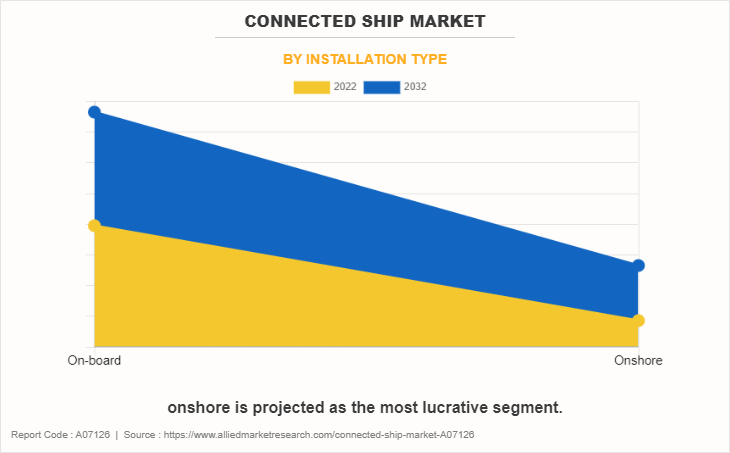
Increase in Global Seaborne Trade
The growth of the connected ship industry is notably influenced by the continuous increase in seaborne trade global. With international trade increasing with every passing day maritime transportation has emerged as one of pillars in the global supply chain. Increased demand for goods and globalization of trade networks have resulted in the intensification of shipping activities. Faced with these developments, the maritime industry is opting more for connected ship technologies to improve efficiency, safety of its crews and overall operational effectiveness. Connected ships allow vessels to monitor themselves in real-time, optimize their navigation routes and improve communication between them and the onshore operations.
This increased connectivity is especially important in regulating the challenges of seaborne trade including timely shipments, adherence to international rules and navigation through crowded maritime routes. With seaborne trade continuing to be an important driver in the world economy, there would continue to be a call for oceanic connected ship solutions that is expected to promote developments and innovation within the maritime sector as it evolves over time with respects of its vis versa changing needs.
High Cost of Digitalization
The costs associated with retrofitting existing vessels with state-of-the-art communications systems, sensors, and data analysis tools are significant, limiting adoption rates, especially for smaller, resource-poor shipping companies. For instance, installing advanced sensor arrays, satellite communication systems, and cybersecurity measures requires significant capital investment. Upgrading an entire fleet to connected ship standards can strain shipownersa financial resources and delay implementation. In addition, costs extend beyond the hardware to include training the crew to effectively operate and manage these advanced systems, increasing the overall financial burden.
Moreover, the high cost of digitalization becomes even more pronounced in a connected ship market industry where profit margins can be tight, and investment decisions are often scrutinized for their return on investment. This financial challenge can result in an uncertainty among shipowners to embrace connected ship technologies, despite the potential long-term benefits in terms of operational efficiency, fuel savings, and safety enhancements. As a result, the maritime industry faces the problem of balancing the immediate financial constraints with the long-term advantages offered by connected ship solutions.
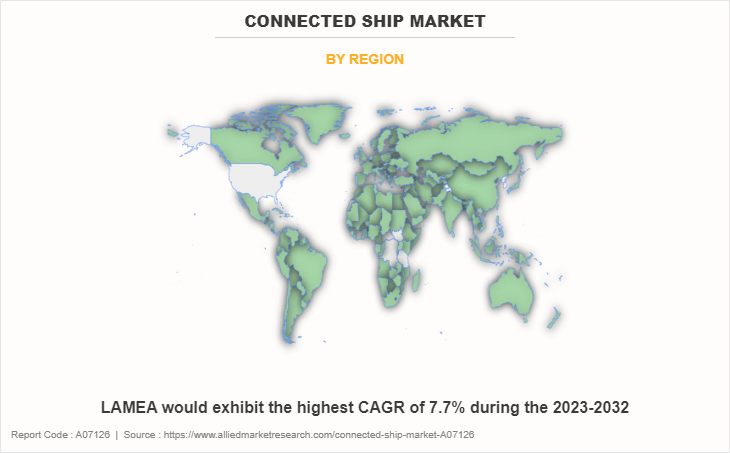
Advancements in Hybrid Propulsion Technology
The integration of hybrid propulsion systems into ships is a breakthrough, providing a harmonious combination of conventional fuel-based and electric propulsion. This technology not only improves fuel efficiency, but also aligns with the maritime industry's increasing focus on sustainability. For example, batteries can be used in conjunction with conventional engines to enable more energy-efficient vessel operations, reducing fuel consumption and emissions. Major companies in the maritime sector are increasing investment in R&D activities to advance the development of hybrid propulsion technology.
Due to this, ship owners are increasingly focusing to connected ship solutions to complement and optimize these advanced propulsion systems. This connectivity supports real-time monitoring of hybrid propulsion system performance and data analysis, enabling proactive maintenance activities and further improving operational efficiency. This interaction between hybrid propulsion technology and connected ship solutions not only addresses environmental issues but also spots the global shipping industry at the front of technological innovation and creates significant growth opportunities for the connected ship market.
Key Benefits For Stakeholders
- This report provides a quantitative analysis of the market segments, current trends, estimations, and dynamics of the connected ship market analysis from 2022 to 2032 to identify the prevailing market opportunities.
- The market research is offered along with information related to key drivers, restraints, and opportunities.
- Porter's five forces analysis highlights the potency of buyers and suppliers to enable stakeholders make profit-oriented business decisions and strengthen their supplier-buyer network.
- In-depth analysis of the market segmentation assists to determine the prevailing market opportunities.
- Major countries in each region are mapped according to their revenue contribution to the global market.
- Market player positioning facilitates benchmarking and provides a clear understanding of the present position of the market players.
- The report includes the analysis of the regional as well as global market trends, key players, market segments, application areas, and market growth strategies.
Connected Ship Market Report Highlights
| Aspects | Details |
| Market Size By 2032 | USD 12.3 billion |
| Growth Rate | CAGR of 6.3% |
| Forecast period | 2022 - 2032 |
| Report Pages | 276 |
| By Ship Type |
|
| By Application |
|
| By Installation Type |
|
| By Region |
|
| Key Market Players | ABB Ltd., Marlink AS, Rockwell Automation, Wartsila Corporation, Emerson Electric, Schneider Electric, Kongsberg Gruppen, Ulstein Group ASA, General Electric, Northrop Grumman Corporation |
The global connected ship market size was valued at $ 6,801.3 million in 2022 and is estimated to reach $ 12,262.0 million by 2032, exhibiting a CAGR of 6.3% from 2023 to 2032.
Increase in seaborne trade, maritime tourism industry, increasing adoption of marine IoT globally and increasing technological developments in vessel monitoring systems are a few upcoming trends of the connected ship market in the world.
Vessel Traffic Management is leading application of connected ship market
Asia-Pacific is the largest region for connected ship industry,
ABB Ltd., Emerson Electric, General Electric, Kongsberg Gruppen, Marlink, Northrop Grumman Corporation, Rockwell Automation, Schneider Electric, Ulstein Group ASA, and Wartsila Corporation.
Loading Table Of Content...
Loading Research Methodology...


